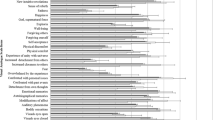Abstract
There have been in recent years increasing claims in both popular and professional literature for a connection between bipolar illness and creativity. A review of studies supporting this claim reveals serious flaws in sampling, methodology, presentation of results, and conclusions. Although there is therefore no evidence for etiological or genetic linkages, it is still necessary to explain interrelationships in those creative persons suffering from the illness. Examples of the work in progress of artists with bipolar disorder, Jackson Pollock and Edvard Munch, illustrate the use of healthy and adaptive creative cognition—janusian and homospatial processes—in the former's breakthrough conception during an improvement phase in treatment leading to the development of the Abstract Expressionist Movement and in the latter's transformation of an hallucination into his famous artwork “The Scream.” Treatment options that do not produce cognitive effects are important for creative persons with bipolar disorder.
Similar content being viewed by others
REFERENCES
Schildkraut JJ, Hirschfeld AJ, Murphy JM: Mind and mood in modern art II: Depressive disorders, spirituality, and early deaths in the abstract expressionist artists of the New York school. American Journal of Psychiatry 151:482–487, 1994.
Jamison K: Touched With Fire. New York, Free Press, 1993.
Andreasen NC: Creativity and mental illness: Prevalence rates in writers and their first degree relatives. American Journal of Psychiatry 144:1288–1292, 1987.
Andreasen NC, Canter A: The creative writer: Psychiatric symptoms and family history. Comprehensive Psychiatry 15:123–131, 1974.
Jamison KR: Mood disorders and patterns of creativity in British writers and artists. Psychiatry 52:125–133, 1989.
Ludwig AM: The Price of Greatness. New York, Guilford Press, 1995.
Rothenberg A: Unpublished manuscript.
Juda A: The relationship between highest mental capacity and psychic abnormalities. American Journal of Psychiatry 106:296–307, 1949.
Eliis HA: A Study of British Genius. London, Grant Richards, 1926.
McNeill TF: Prebirth and postbirth influence on the relationship between creative ability and mental illness. Journal of Personality 39:391–406, 1971.
Richards R, Kinney DK, Lunde I, et al: Creativity in manic-depressives, cyclothymes, their normal relatives, and control subjects. Journal of Abnormal Psychology 97:281–288, 1988.
Rothenberg A: The process of janusian thinking in creativity. Archives of General Psychiatry 24:195–205, 1971.
Rothenberg A:Word association and creativity. Psychological Reports 33:3–12, 1973.
Rothenberg A: Opposite responding as a measure of creativity. Psychological Reports 33:15–18, 1973.
Rothenberg A: Psychopathology and creative cognition. A comparison of hospitalized patients, Nobel laureates, and controls. Archives of General Psychiatry 40:937–942, 1983.
Rothenberg A: The janusian process in scientific creativity. Creativity Research Journal 9:207–232, 1996.
Rothenberg A: Homospatial thinking in creativity. Archives of General Psychiatry 33:17–26, 1976.
Rothenberg A: The Emerging Goddess: The Creative Process in Art, Science and Other Fields. Chicago, University of Chicago Press, 1979.
Rothenberg A, Sobel RS: Adaptation and cognition. An experimental study of creative thinking. Journal of Nervous and Mental Disease 168:370–374, 1980.
Rothenberg A, Sobel RS: Adaptation and cognition II. Experimental study of homospatial thinking in artistic creativity. Journal of Nervous and Mental Disease 169:417–423, 1981.
Rothenberg A: Artistic creation as stimulated by superimposed versus combinedcomposite visual images. Journal of Personality & Social Psychology 50:370–381, 1986.
Rothenberg A: Creativity and the homospatial process: Experimental studies. Psychiatric Clinics of North America 11:443–459, 1988.
Heller RH: Munch. His Life and Work. London, Calmann and Cooper Ltd., 1984.
Stang N: Edvard Munch. Oslo, Norway, Grundt, 1972.
Heller RH: Edvard Munch: The Scream. New York, Viking Press, 1972.
Wysuph CL: Jackson Pollock: Psychoanalytic Drawings. New York, Horizon Press, 1970.
Naifeh S, Smith GW: Jackson Pollock. An American Saga. New York, Potter, 1989.
Henderson J: Jackson Pollock: A psychological commentary. Unpublished essay.
Cernuschi C: Jackson Pollock: “Psychoanalytic” Drawings. Durham NC, Duke University Press, 1992.
O'Connor FV, Thaw EV: Jackson Pollock: A Catalogue Raisonne of Paintings, Drawings, and Other Works. 4 Vols. New Haven, Yale U Press, 1978.
Hamilton I: Conversation with Robert Lowell. Modern Occasions 2:28–48, 1972.
Seager A: The Glass House. The Life of Theodore Roethke. New York, McGraw-Hill, 1968.
Hamilton I: Robert Lowell: A Biography. New York, Random House, 1982.
Hochner AE: Papa Hemingway: The Ecstasy and the Sorrow. New York, Morrow, 1983.
Rothenberg A: Creativity and Madness. New Findings and Old Stereotypes. Baltimore, Johns Hopkins University Press, 1990.
Shaw ED, Mann JJ, Stokes PE, et al: Effects of lithium carbonate on associative productivity and idiosyncrasy in bipolar outpatients. American Journal of Psychiatry 143:1166–1169, 1986.
Judd LL, Hubbard B, Janowsky DS, et al: The effect of lithium carbonate on the cognitive function of normal subjects. Archives of General Psychiatry 34:355–357, 1979.
Schou M: Artistic productivity and lithium prophylaxis in manic-depressive illness. British Journal of Psychiatry 135:97–103, 1979.
Sussman N: Gabapentin and lamotrigine: Alternative agents for the treatment of bipolar disorder. Primary Psychiatry 4:26–42, 1997.
Author information
Authors and Affiliations
Rights and permissions
About this article
Cite this article
Rothenberg, A. Bipolar Illness, Creativity, and Treatment. Psychiatr Q 72, 131–147 (2001). https://doi.org/10.1023/A:1010367525951
Issue Date:
DOI: https://doi.org/10.1023/A:1010367525951




